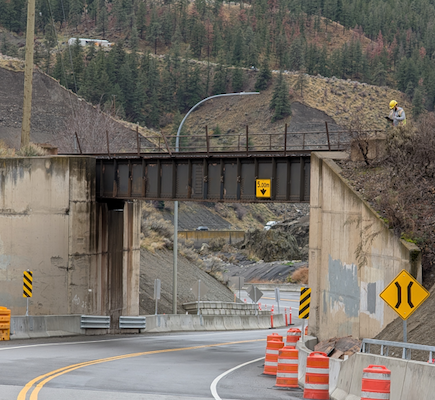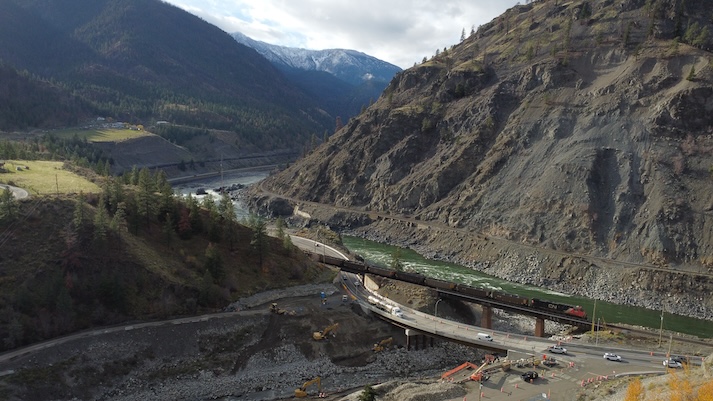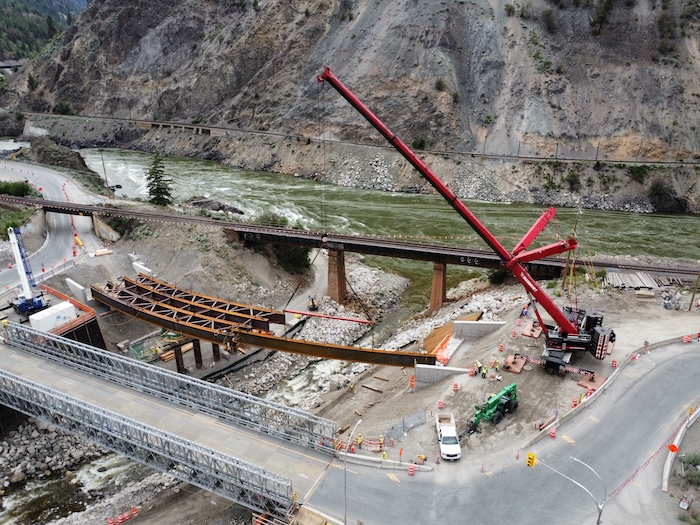
2025 #CCEAwards Showcase: Nicomen River Bridge Replacement
October 24, 2025
By CCE
“A complex, critical project that demonstrated the strengths an alliance delivery model and risk-sharing among stakeholders.” – Jury
Category: Transportation
Award of Excellence winner: Kiewit
The replacement of Highway 1’s Nicomen River Bridge, delivered through an Alliance model, restored critical infrastructure following the severe November 2021 B.C. floods. The project provided a new, resilient, low-maintenance bridge, enhanced freight mobility by resolving railway clearance issues, prioritized environmental protection throughout construction, strengthened regional connectivity, supported Indigenous employment and engagement and promoted long-term sustainability. The collaborative approach behind it has ensured lasting benefits for both the community and the provincial economy.
Alliance achievements
Traditional procurement models sometimes lead to inefficiencies and misaligned priorities. The Alliance delivery model integrated the client, engineers and contractor into a single, collaborative team, which enabled real-time decision-making, shared risk management and achieved cost efficiencies.
The project’s aim was to replace a flood-damaged bridge along a critical corridor in southern British Columbia, but the Alliance model also helped identify opportunities beyond the original scope, such as lowering the roadway beneath the Canadian Pacific Kansas City (CPKC) railway underpass to increase its substandard vertical clearance to 5 m. While this improvement was not included in the original plan, the team recognized it would enhance freight mobility immediately and prevent costly modifications in the future. The change eliminated a long-standing regional bottleneck, reducing detours for freight carriers and improving transportation efficiency along the corridor.
The tools for the job
Kiewit designed a two-span, 69-m curved steel plate girder bridge to withstand seismic activity, flood debris and extreme scour. Weathering steel, semi-integral abutments and stainless-steel shear keys eliminated expansion joints to reduce the bridge’s maintenance needs and extend its expected service life.
Weathering steel was specified for the steel superstructure and cased drilled shaft pier columns to eliminate the need for recoating the steelwork. Semi-integral abutments and a continuous concrete deck were designed to eliminate deck joints, which have limited service life and, once damaged, require replacement and could allow water passage that would accelerate deterioration of adjacent concrete and steelwork.
Stainless steel rub-plates were placed on the shear keys at the abutments to support a longer service life than more typical black steel or polytetrafluoroethylene (PTFE) materials.
Design features to reduce scour risk and associated maintenance costs include piled foundations and the elimination of in-water piers relative to the existing bridge, as well as locating the pier outside the Q200 flood perimeter by using asymmetric spans of 42 and 27 m.
Innovative construction techniques also streamlined execution. At the end of the project, for example, self-propelled modular transporters (SPMTs) were used to move the temporary detour bridge off-site for dismantling, reducing the need for extended traffic closures and for work adjacent to heavy traffic, thus enhancing worker safety and increasing efficiency. The SMPTs significantly reduced crane operations, lowering fuel consumption and emissions.
To optimize geotechnical performance, real-time soil assessments and adaptive foundation strategies were implemented during the construction phase. These allowed the engineers to reduce pile lengths by 12 m without compromising the bridge’s structural integrity.
Environmental and social considerations were also integrated into the project’s design and execution. By minimizing in-water work and implementing restorative measures, the team protected fish habitats and supported local ecosystems. Such measures included spawning gravel placement, ensuring suitable habitats for fish reproduction and riparian restoration, which stabilized the riverbanks and improved water quality.
Additionally, bioengineered erosion control techniques, such as the use of locally sourced and Indigenous-supplied willow trees, reinforced the embankments, improved the habitat, reduced sediment runoff and enhanced ecological resilience. To further minimize disruption, the team closely monitored water quality throughout construction, ensuring compliance with environmental regulations.
Project complications
The project’s remote location, complex geometry and high-risk construction activities set it apart from conventional bridge replacements.
One of the most complex aspects was steel erection, due to the bridge’s tight-radius alignment, steep slope and skewed supports. These factors called for precise fabrication and installation, as even minor misalignments could result in costly rework and project delays.
To mitigate risks, the project team deployed additional engineering resources and tools, including third-party consultant inspections, three-dimensional (3-D) total-station girder fabrication surveys and finite element construction staging analyses, to help ensure accurate component fit-up and seamless execution.
The installation and subsequent removal of the temporary modular detour bridge also posed significant challenges. Multiple stakeholders—including the B.C. Ministry of Transportation and Transit (MoTT), the engineer of record and the erection subcontractors—co-ordinated their efforts such that the team could successfully execute the high-risk procedure during a single-night highway closure, minimizing disruption to the flow of traffic.
Unforeseen geotechnical conditions demanded real-time adjustments. Initial soil testing suggested weak foundations, but on-site assessments during construction revealed stronger-than-expected conditions, allowing the team to reduce pile lengths by 12 m and modify the design to incorporate rock sockets, leading to material savings, enhanced stability and a three-week schedule acceleration.

The project offered an opportunity to lower the roadway beneath railway underpass, increasing its previously substandard vertical clearance. Photo courtesy Kiewit.
Community benefits
The bridge sits immediately adjacent to a First Nation community in an archaeologically sensitive area.
This infrastructure upgrade delivered significant social and economic benefits by strengthening regional connectivity, expanding employment opportunities and improving mobility for communities, businesses and freight operators alike.
The project exceeded employment and subcontracting targets for direct equity groups, with 44% of its workforce comprising underrepresented groups. Indigenous-owned businesses, in particular, played key roles in traffic control, environmental monitoring and material supply.
Community engagement included career fairs, educational programs and cultural ceremonies, fostering long-term relationships and economic inclusion. Indigenous monitors participated in daily site inspections, ensuring cultural heritage considerations and environmental best practices were respected.
The project improved regional accessibility to support local industries, tourism, and emergency services. The low-maintenance bridge was designed to reduce long-term public expenditures by minimizing future repair and maintenance costs.
Aligned priorities
The project successfully met and exceeded the MoTT’s objectives by delivering resilient, cost-effective and sustainable infrastructure ahead of schedule and well under budget. The approach to both design and construction focused on enhancing durability, minimizing long-term maintenance and improving regional transportation efficiency, which aligned with the client’s own strategic priorities.
In these ways, the project has set a new standard for transportation infrastructure in British Columbia, meeting the client’s objectives and enhancing the province’s highway network.
Nicomen River Bridge Replacement, near Spences Bridge, B.C.
Award-winning firm (prime consultant, lead designer): Kiewit, Burnaby, B.C. (Domenic Serrand; Paulo (Jorge) Antunes, P.Eng.; Matthew Lea, P.Eng.; Michael Rakowski, P.Eng.; Alex Breese, P.Eng.; Sylvain Lehouillier, P.Eng.; Jonathan Ho, P.Eng.; Michael Brosch, P.Eng.).
Owner: B.C. Ministry of Transportation and Transit.
Other key players: Disaster Financial Assistance Arrangements (DFAA) program (funding), Marcon Metalfab (permanent bearings), Rapid-Span Structures (permanent steel girders), Rapid-Span Precast (permanent deck panels), Varsteel/Dominion Pipe and Piling (pile supply), Coast Range Concrete (concrete supply), Nucor Rebar Fabrication (rebar supply and installation), KWH Constructors (steel girder installation), Amrize/Lafarge Canada (asphalt milling and paving), Cooks Ferry Alliance Team/Quattro Constructors (earthworks).

